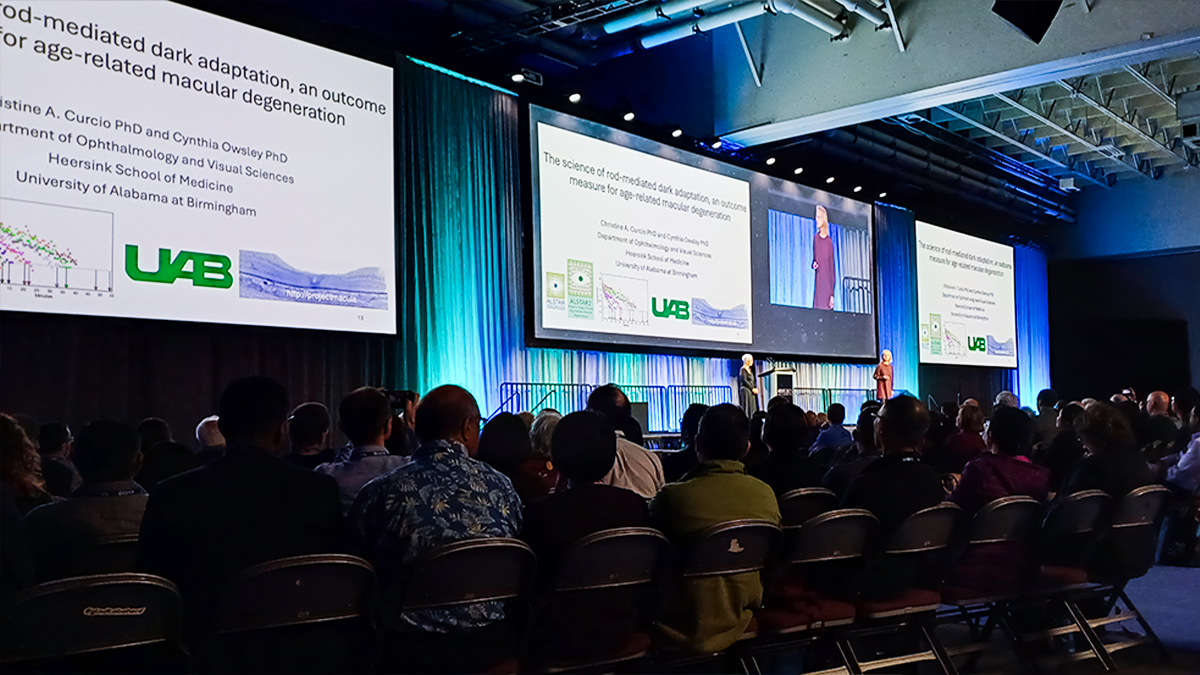Day 2 of the annual meeting of The Association for Research in Vision and Ophthalmology (ARVO 2025) in Salt Lake City was more than an event—it was a masterclass in groundbreaking science, personal legacy and visionary thinking.
Inside the Salt Palace Convention Center, two of vision science’s most prestigious honors—the Proctor Medal and the Friedenwald Award—were celebrated with lectures that both honored the past and pointed to the future.
The 2025 Proctor Medal Lecture
Let’s start with the powerhouse duo of Dr. Cynthia Owsley and Dr. Christine Curcio (United States), co-recipients of the Proctor Medal, who took us on a journey through decades of groundbreaking research on age-related macular degeneration (AMD).
READ MORE: Protocol for Classifying and Monitoring AMD Patients
Dr. Owsley kicked things off with a clear message: if we want to stop AMD, we need to act early. Really early. Her talk focused on rod-mediated dark adaptation (RMDA) and why it may be the first functional biomarker for AMD’s early stages.
“Our goal is the prevention of AMD onset and arresting its earliest progression,” she told the audience. “This is preferable not just for patients, but also for families, providers and payers.”
She explained how delays in RMDA are predictive of AMD’s onset—years before structural changes show up in imaging. Her clinical trials, particularly the Alabama Study on Early Age-Related Macular Degeneration (ALSTAR1 & ALSTAR22) studies, have revealed just how powerful RMDA testing can be for early detection, trial enrollment and measuring treatment success.
Then came Dr. Curcio, offering a perfect complement to Dr. Owsley’s clinical insight with her stunning histological research. For those unfamiliar with her work, Dr. Curcio helped create the photoreceptor topography maps that every med student studies—and she’s far from finished.
She showed how the buildup of lipoproteins and cholesterol in Bruch’s membrane, particularly near the fovea, plays a central role in AMD progression. Her data revealed a “lipid oil spill” under the retina, one that could be targeted for treatment long before vision loss begins.
READ MORE: Advances in AMD and DME Take Center Stage at APAO 2025
The 2025 Friedenwald Award Lecture
If the Proctor Medal Lecture was about unlocking the future of AMD, the Friedenwald Award Lecture was about understanding where it all begins: retinal development.
Dr. Connie Cepko (United States), a developmental biologist and geneticist and a longtime professor at Harvard Medical School, delivered a lecture that felt both brilliant and personal. Her talk revealed how this complex tissue is built from the inside out—one radial unit at a time.
“It’s beautiful,” she said, pointing to a fluorescent image of a mouse retina. “This structure is what drew me to the retina in the first place.”
Her lecture was a tour de force in developmental genetics. Using a combination of lineage tracing, retroviral vectors and single-cell RNA sequencing, Dr. Cepko painted the retina not just as a network of cells, but as a living, evolving map of fate decisions, shaped by both stochasticity and structure.
READ MORE: Visualizing the Retinal Vasculature
Dr. Cepko walked us through how founder cells in the developing retina give rise to incredibly diverse types of neurons through precise, timed divisions. Her work with retroviral lineage tracing, RNA sequencing and even avian models like chickens and lizards gave us a broader picture of how nature builds the retina—and what might go wrong in disease.
She shared her latest model, The Retina: A Mosaic of Radial Founder Cell Clones—a paradigm-shifting framework suggesting that the retina develops through radial columns, each derived from a single multipotent retinal progenitor cell (RPC).
Each of these radial “clones” gives rise to a full complement of retinal neurons, not randomly or solely due to external signals, but through intrinsic programs encoded within the progenitor itself.
This model directly challenges the long-held view that retinal cell fate is mostly driven by extrinsic cues or chance. Instead, it positions RPCs as central players in shaping the spatial and functional architecture of the retina from within—programmed with a sort of internal developmental clock and logic.
By mapping how these radial clonal units expand and diversify, Dr. Cepko’s model could transform how scientists understand eye development, species differences and even approaches to regenerative therapies in vision science.
Honoring the past, illuminating the future
Day 2 at ARVO 2025 reminded us that science isn’t just about what we know—it’s about who’s asking the questions and how those questions evolve.
Whether it was Drs. Owsley and Curcio redefining how we screen for AMD or Dr. Cepko pulling back the curtain on how the retina takes shape, today’s award lectures weren’t just about honoring past achievements. They were about pointing the way forward.
READ MORE: Follow our daily conference coverage at ARVO 2025 here!
Editor’s Note: Reporting for this story took place during the annual meeting of The Association for Research in Vision and Ophthalmology (ARVO 2025) being held from 4-8 May in Salt Lake City, Utah, United States.
References
- Owsley C, Huisingh C, Jackson GR, et al. Associations between abnormal rod-mediated dark adaptation and health and functioning in older adults with normal macular health. Invest Ophthalmol Vis Sci. 2014;55(8):4776-4789.
- Curcio CA, McGwin G Jr, Sadda SR, et al. Functionally validated imaging endpoints in the Alabama study on early age-related macular degeneration 2 (ALSTAR2): design and methods. BMC Ophthalmol. 2020;20(1):196.



